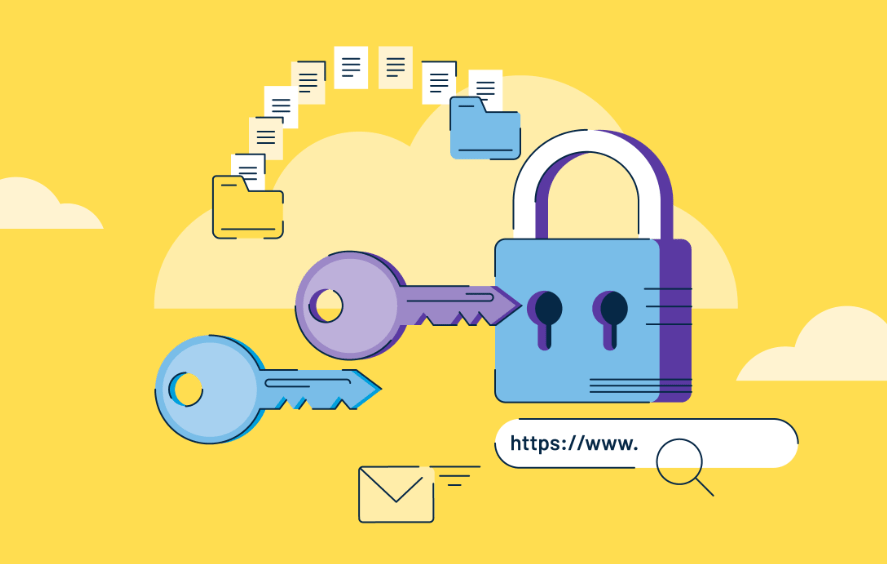In today’s digital world, protecting your data is paramount. Did you know that public key encryption, a method used in cryptography, plays a vital role in securing your information?
This blog will unravel how this form of encryption ensures data integrity and helps keep unauthorized individuals at bay.
Key Takeaways
- Public key encryption uses two keys, a public key and a private key, to ensure data integrity.
- The encryption process involves using the recipient’s public key to encrypt messages, which can only be decrypted using their corresponding private key.
- Digital signatures are used to verify the authenticity and integrity of encrypted data.
- Public key encryption is used in web server security, identity authentication, email encryption, and cryptocurrency.
What is Public Key Encryption?

Public Key Encryption is a form of asymmetric encryption that utilizes both a public key and a private key to secure data.
A form of asymmetric encryption
Public key encryption is a type of asymmetric encryption. This means it uses two keys and not just one. These are the public and private keys. The public key is what everyone can see.
It’s like your mailbox where people drop letters for you. But only you should have the private key to open that mailbox, just like in real life! This kind of encryption secures data very well because even if someone has your public key, they can’t read your messages without the private key.
Uses two keys: public and private
Public key encryption uses two keys. One key is public and the other one is private. The public key can be given to anyone who wants to send you a message. This key locks or encrypts the data.
The second key is private. You should never share your private key with others! It unlocks or decrypts the data sent to you. Only this special pair of keys can work together – lock and unlock, encrypt and decrypt.
No other keys will do it right! Protection from unauthorized access gets strong because of these two keys.
How Public Key Encryption Works
Public key encryption works through the process of key generation, where a pair of keys – a public key and a private key – is created. The encryption process involves using the recipient’s public key to encrypt the message, which can then only be decrypted using their corresponding private key.
Additionally, digital signatures are used to verify the authenticity and integrity of the encrypted data.
Key generation
Key generation in public key encryption is a vital first step. Here are the steps:
- A pair of keys gets made.
- One key stays private or secret.
- The other key is known to all and is called the public key.
- These keys work together in encryption and decryption.
- The keys use math to protect data.
Encryption process
Public key encryption uses a two-step process to secure data. Here’s how it works:
- The sender generates a pair of keys: a public key and a private key.
- The public key is shared with others, while the private key is kept secret.
- When the sender wants to encrypt a message, they use the recipient’s public key to encode the message.
- The encrypted message can only be decrypted using the recipient’s private key, ensuring that only the intended recipient can read it.
Decryption process
The decryption process in public key encryption involves the following steps:
- The recipient uses their private key to decrypt the received ciphertext.
- The private key is kept secret and only known to the recipient, ensuring secure decryption.
- During decryption, the recipient’s private key reverses the encryption process, converting the ciphertext back into plaintext.
- This step ensures that only the intended recipient can access and read the decrypted message.
- After decryption, the recipient can verify the integrity of the message by comparing it with a message authentication code (MAC) or digital signature.
- The MAC or digital signature confirms that the message has not been altered during transmission, ensuring data integrity.
Digital signatures
Digital signatures are a crucial aspect of public key encryption. They provide authentication and ensure the integrity of data transmission. Here’s how they work:
- Digital signatures use cryptographic algorithms to create a unique identifier for a digital message.
- The signature is created using the sender’s private key and is attached to the message.
- When the recipient receives the message, they can verify the signature using the sender’s public key.
- If the signature is valid, it means that the message hasn’t been tampered with or altered during transmission.
- Digital signatures also provide non – repudiation, meaning that the sender cannot deny sending the message.
Applications of Public Key Encryption

Public Key Encryption is widely used for web server security, identity authentication, email encryption, and cryptocurrency. Read on to learn how it ensures data integrity.
Web server security
Web server security is critical for protecting sensitive information and ensuring data integrity. Public key encryption plays a vital role in securing web servers. It allows for the secure exchange of information between clients and servers by encrypting data with the server’s public key.
This ensures that only authorized parties can access and decrypt the information, preventing unauthorized access to sensitive data. Additionally, public key encryption enables the use of digital signatures, which authenticate the identity of the server and ensure that messages have not been tampered with during transmission.
By implementing public key encryption, web servers can provide a secure environment for online transactions, user authentication, and safeguarding confidential information from potential threats or attacks.
Identity authentication
Identity authentication is an important application of public key encryption. It uses the unique properties of cryptographic protocols to verify the identity of a user. With public key cryptography, e-signatures are commonly used for identity authentication.
These e-signatures use mathematical methods to ensure data integrity and authenticate the sender’s identity. By encrypting a message with the receiver’s public key, only the intended recipient can decrypt and read it, providing a secure way to verify identities in digital transactions.
This helps protect against unauthorized access and ensures that sensitive information remains confidential during communication processes.
Email encryption
Email encryption is an important application of public key encryption. It helps ensure the security and privacy of email communications. With email encryption, messages are encrypted using the recipient’s public key before they are sent.
This means that only the intended recipient, who has the corresponding private key, can decrypt and read the message. These features are essential for bypassing spam traps and maintaining trustworthy communication channels.
By using public key cryptography in email communication, sensitive information can be protected from unauthorized access and ensure that data remains confidential and secure.
Cryptocurrency
Cryptocurrency is another application of public key encryption. It uses cryptographic protocols to ensure secure transactions and protect the privacy of user data. With cryptocurrencies like Bitcoin, transactions are encrypted using a recipient’s public key, ensuring that only they can access and use the funds.
This technology provides a decentralized and secure way to transfer money without relying on traditional financial institutions. Public key encryption plays a vital role in maintaining the integrity and security of cryptocurrency transactions, making it a trusted method for those looking to buy Chainlink and other digital assets..
Benefits and Challenges of Public Key Encryption

Public Key Encryption ensures data integrity through its ability to protect against unauthorized access and maintain the confidentiality of sensitive information.
Ensures data integrity
Public key encryption plays a crucial role in ensuring data integrity. By encrypting messages with the recipient’s public key, it ensures that only the intended receiver can decrypt and read them.
This process also includes checking the validity of the received message, making sure it matches what was sent. With public key encryption, data remains secure during transmission, protecting against unauthorized access and maintaining its integrity.
It is widely used in applications like secure communication protocols and digital signatures to ensure the privacy and authenticity of information.
Protects against unauthorized access
Public key encryption provides an important safeguard against unauthorized access. With public key encryption, messages are encrypted using the recipient’s public key, which can only be decrypted with the corresponding private key held by the receiver.
This means that even if someone intercepts the encrypted message, they won’t be able to decipher its contents without the private key. This ensures that only those who have been authorized and given the necessary private keys can decrypt and access sensitive information.
By protecting against unauthorized access, public key encryption helps ensure data security and maintains confidentiality for secure communication.
Public Key Encryption also plays a vital role in maintaining data integrity by preventing unauthorized tampering or modifications to messages during transmission. Through digital signatures, which is part of public key encryption, senders can sign their messages using their private keys.
Quantum computing threat
Quantum computing poses a potential threat to public key encryption. Traditional encryption algorithms used in public key cryptography rely on the difficulty of factoring large numbers, which would take years for conventional computers.
However, quantum computers could potentially solve these problems much faster, rendering current encryption methods vulnerable.
The power of quantum computing lies in its ability to perform complex calculations simultaneously and reduce the time required to break encryption keys significantly. This means that sensitive data protected by today’s public key encryption algorithms could potentially be decrypted by future quantum computers.
To address this threat, researchers are actively working on developing new cryptographic protocols that can withstand attacks from quantum computers. These post-quantum cryptography (PQC) techniques involve using different mathematical approaches that are suitably resistant to quantum attacks.
Conclusion
In conclusion, public key encryption plays a crucial role in ensuring data integrity. By using two keys – a public key for encryption and a private key for decryption – it creates a secure communication channel.
This technology not only protects against unauthorized access but also verifies the authenticity of the received message, safeguarding the integrity of transmitted data. With its widespread usage and recommendation from industry experts, public key encryption remains an essential tool for maintaining data security in today’s digital world.
Frequently Asked Questions
What is public key encryption?
Public key encryption is a method of securing data by using two keys: a public key to encrypt the data and a private key to decrypt it.
How does public key encryption ensure data integrity?
Public key encryption ensures data integrity by verifying that the received data has not been tampered with during transmission. The recipient uses their private key to decrypt and check the digital signature attached to the encrypted message.
Is public key encryption safe?
Yes, public key encryption is considered safe because it uses complex algorithms and a pair of unique keys for secure communication. However, it is important to use strong keys and keep them confidential.
Can anyone intercept my encrypted messages?
While it is theoretically possible for someone to intercept your encrypted messages, they would not be able to read or understand them without access to the corresponding private key used for decryption.
Can public key encryption protect against all types of cyber attacks?
While public key encryption can provide strong security measures, it may not protect against all types of cyber attacks like phishing or social engineering, which rely on human vulnerabilities rather than technical weaknesses in cryptography systems.




